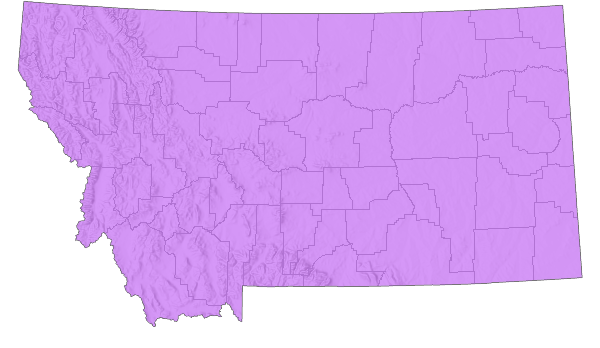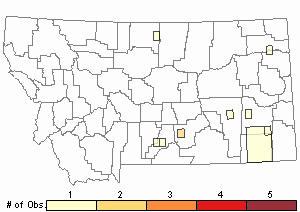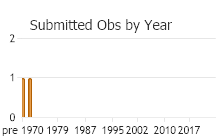View in other NatureServe Network Field Guides
NatureServe
Montana
Utah
Wyoming
Idaho
Wisconsin
British Columbia
South Carolina
Yukon
California
New York
White-crossed Grasshopper - Aulocara femoratum
Other Names:
White Cross Grasshopper
General Description
The following comes from Hebard (1928), Brooks (1958), Helfer (1971), Otte (1981), Capinera and Sechrist (1982), Vickery and Kevan (1985), McDaniel (1987), Pfadt (2002), Capinera et al. (2004), and Scott (2010). This is a medium sized grasshopper with an oversized head bearing a dark streak below the eye to the top of the mandibles. The dorsal area of the pronotum is dark with a light X-like marking. The lateral side of the pronotum has a large black marking. The outer face of the hind femur is cream colored with 3 conspicuous black stripes on the upper surface continuing onto the inner surface. Hind tibia is blue.
Phenology
Overwinters in the egg stage. Nymphs hatch in early June and continue to occur into August. Adults occur from mid-July to mid- October (Capinera et al. 2004, Capinera and Sechrist 1982, Pfadt 2002, Scott 2010, and Vickery and Kevan 1985).
Diagnostic Characteristics
The following is taken from Hebard (1928), Brooks (1958), Helfer (1971), Otte (1981), Capinera and Sechrist (1982), Vickery and Kevan (1985), McDaniel (1987), Pfadt (2002), Capinera et al. (2004), and Scott (2010). The body length of males is 15 to 17 mm and females 20 to 25 mm. Females are significantly larger than males in this species. The female 8th ventral abdominal segment’s posterior margin has two deep clefts. The wings (tegmina) usually do not reach the tip of the abdomen, although there are some rare individuals collected with wings extending beyond the abdominal tip.
The White-crossed Grasshopper is similar to the
Big-headed Grasshopper (
Aulocara eliotti). A quick separation can be made by comparing the shapes of the female 8th ventral segment’s posterior margins.
A. elliotti lacks deep clefts in the margin. See that species for other diagnostic characters.
Species Range
Montana Range
Range Descriptions

 Native
Native
Range Comments
This species is widely distributed across the western grasslands. North on the southern borders of Alberta and Saskatchewan, south across the Western Plains and Mountain States to Durango, Mexico. Although widely spread, this species occurs in only 60% of the range of its congener, the Big-headed Grasshopper (Aulocara eliotti). In Montana, reported for 20 counties (Capinera et al. 2004, Capinera and Sechrist 1982, Otte 1984, Pfadt 2002, Scott 2010, and Vickery and Kevan 1985).
Observations in Montana Natural Heritage Program Database
Number of Observations: 12
(Click on the following maps and charts to see full sized version)
Map Help and Descriptions
Relative Density

Recency


 (Observations spanning multiple months or years are excluded from time charts)
(Observations spanning multiple months or years are excluded from time charts)
Habitat
Found most frequently in shortgrass, mixed-grass and bunchgrass prairies where
western wheatgrass (
Elymus smithii),
needle-and-thread (
Stipa comata), and
blue gramma (
Bouteloua gracilis) are abundant (Capinera et al. 2004, Capinera and Sechrist 1982, Otte 1984, Pfadt 2002, and Vickery and Kevan 1985).
Food Habits
Feeds almost exclusively on grasses and sedges, favoring
western wheatgrass (
Elymus smithii), and
needleleaf sedge (
Carex duriuscula). A study revealed a difference in diets between males and females. The males ingested much larger amounts of short grass species and sedges, whereas the females consumed larger amounts of mid grasses such as western wheatgrass (Pfadt 2002, and Schell et al. 2005).
Reproductive Characteristics
Males court females with conspicuous visual signals with the hind femur. No observations of copulation have been recorded. Females select a small bare soil area (1 to 6 square inches) surrounded by
blue gramma (
Bouteloua gracilis) or other short grass to deposit her eggs to a depth of about one-eighth to three-quarters of an inch. Each pod contains 9 to 11 eggs. Upon hatching the White-crossed Grasshopper passes through 4 instars in males, 5 instars in females. Males require a minimum of 30 days to become adults, females require 42 days to reach the adult stage. There is one generation per year (Capinera and Sechrist 1982, Otte 1984, Pfadt 2002, and Vickery and Kevan 1985).
Management
This species can be destructive of rangelands. It is usually sub-dominate in outbreak assemblages with the
Big-headed Grasshopper (
Aulocara eliotti). It rarely reaches high population densities, and usually does not last more than one year (Pfadt 2002, and Schell et al. 2005).
Stewardship Responsibility
References
- Literature Cited AboveLegend:
 View Online Publication
View Online Publication Brooks, A.R. 1958. Acridoidea of Southern Alberta, Saskatchewan, and Manitoba (Orthoptera). The Canadian Entomologist (Supplement 9) 90:5-92.
Brooks, A.R. 1958. Acridoidea of Southern Alberta, Saskatchewan, and Manitoba (Orthoptera). The Canadian Entomologist (Supplement 9) 90:5-92. Capinera, J.L. and T.S. Sechrist. 1982. Grasshoppers of Colorado: Identification, Biology, and Management. Fort Collins, CO: Colorado State University Experiment Station, Bulletin 584S. 161 p.
Capinera, J.L. and T.S. Sechrist. 1982. Grasshoppers of Colorado: Identification, Biology, and Management. Fort Collins, CO: Colorado State University Experiment Station, Bulletin 584S. 161 p. Capinera, J.L., R.D. Scott, and T.J. Walker. 2004. Field Guide to Grasshoppers, Katydids, and Crickets of the United States. Ithaca, NY. Cornell University Press.
Capinera, J.L., R.D. Scott, and T.J. Walker. 2004. Field Guide to Grasshoppers, Katydids, and Crickets of the United States. Ithaca, NY. Cornell University Press. Hebard, M. 1928. The Orthoptera of Montana. Proceedings of the Academy of Natural Sciences of Philadelphia, Vol. 80:211-306.
Hebard, M. 1928. The Orthoptera of Montana. Proceedings of the Academy of Natural Sciences of Philadelphia, Vol. 80:211-306. Helfer, J.R. 1971. How to Know the Grasshoppers, Crickets, Cockroaches, and Their Allies. Revised edition (out of print), Mineola, NY: Dover Publications.
Helfer, J.R. 1971. How to Know the Grasshoppers, Crickets, Cockroaches, and Their Allies. Revised edition (out of print), Mineola, NY: Dover Publications. McDaniel, B. 1987. Grasshoppers of South Dakota. Brookings, SD: South Dakota Agricultural Experiment Station, Bulletin TB 89.
McDaniel, B. 1987. Grasshoppers of South Dakota. Brookings, SD: South Dakota Agricultural Experiment Station, Bulletin TB 89. Otte, Daniel. 1981. The North American Grasshoppers. Volume 1. Acrididae (Gomphocerinae and Acridinae). Harvard University Press. 275 pp.
Otte, Daniel. 1981. The North American Grasshoppers. Volume 1. Acrididae (Gomphocerinae and Acridinae). Harvard University Press. 275 pp. Pfadt, R.E. 2002. Field Guide to Common Western Grasshoppers, 3rd edition. Laramie, WY: Wyoming Agricultural Experiment Station, Bulletin 912, modified by S. Schell and S. Schell for electronic publication. Accessed 19 February 2020. http://www.uwyo.edu/entomology/grasshoppers/field-guide/index.html#fieldguidetoc
Pfadt, R.E. 2002. Field Guide to Common Western Grasshoppers, 3rd edition. Laramie, WY: Wyoming Agricultural Experiment Station, Bulletin 912, modified by S. Schell and S. Schell for electronic publication. Accessed 19 February 2020. http://www.uwyo.edu/entomology/grasshoppers/field-guide/index.html#fieldguidetoc Schell, S.P., A.V. Latchininsky, and B.A. Shambaugh. 2005. Common Wyoming Pest Grasshoppers. 2nd Edition B-1161.Laramie, WY: University of Wyoming Cooperative Extension Service and Department of Renewable Resources. 76 p.
Schell, S.P., A.V. Latchininsky, and B.A. Shambaugh. 2005. Common Wyoming Pest Grasshoppers. 2nd Edition B-1161.Laramie, WY: University of Wyoming Cooperative Extension Service and Department of Renewable Resources. 76 p. Scott, R.D. 2010. Montana Grasshoppers, Katydids, and Crickets A Pictorial Field Guide to the Orthoptera. MagpieMTGraphics, Billings, MT.
Scott, R.D. 2010. Montana Grasshoppers, Katydids, and Crickets A Pictorial Field Guide to the Orthoptera. MagpieMTGraphics, Billings, MT. Vickery, V. R. and D. K. M. Kevan. 1985. The grasshopper, crickets, and related insects of Canada and adjacent regions. Biosystematics Research Institute, Ottawa, Ontario. Publication Number 1777. 918 pp.
Vickery, V. R. and D. K. M. Kevan. 1985. The grasshopper, crickets, and related insects of Canada and adjacent regions. Biosystematics Research Institute, Ottawa, Ontario. Publication Number 1777. 918 pp.
- Additional ReferencesLegend:
 View Online Publication
View Online Publication
Do you know of a citation we're missing? Anderson, N.L. 1951. Field studies on the biology of range grasshoppers of southeastern Montana. M.Sc. Thesis. Bozeman, Montana: Montana State University. 96 p.
Anderson, N.L. 1951. Field studies on the biology of range grasshoppers of southeastern Montana. M.Sc. Thesis. Bozeman, Montana: Montana State University. 96 p. Anderson, N.L. 1962. Grasshopper-vegetation relationships on Montana grasslands. Ph.D Dissertation. Bozeman, Montana: Montana State University. 73 p.
Anderson, N.L. 1962. Grasshopper-vegetation relationships on Montana grasslands. Ph.D Dissertation. Bozeman, Montana: Montana State University. 73 p. Hebard, M. 1932. Notes on Montana Orthoptera. Proceedings of the Academy of Natural Sciences of Philadelphia. V. 84. pp 251-257.
Hebard, M. 1932. Notes on Montana Orthoptera. Proceedings of the Academy of Natural Sciences of Philadelphia. V. 84. pp 251-257. Mussgnug, G.L. 1972. The structure and performance of an adult population of Aulocara elliotti (Thomas) (Orthoptera, Acrididae) near Billings, Montana. M.Sc. Thesis. Bozeman, MT: Montana State University. 97 p.
Mussgnug, G.L. 1972. The structure and performance of an adult population of Aulocara elliotti (Thomas) (Orthoptera, Acrididae) near Billings, Montana. M.Sc. Thesis. Bozeman, MT: Montana State University. 97 p. Skinner, K.F. 1995. Plant and grasshopper community composition: indicators & interactions across three spatial scales. M.Sc. Thesis. Bozeman, MT: Montana State University. 144 p.
Skinner, K.F. 1995. Plant and grasshopper community composition: indicators & interactions across three spatial scales. M.Sc. Thesis. Bozeman, MT: Montana State University. 144 p.
- Web Search Engines for Articles on "White-crossed Grasshopper"
- Additional Sources of Information Related to "Insects"





